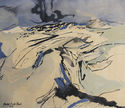
19th, 20th & 21st Century Fine Prints
707-546-7352 · fax 707-546-7924 · web: www.annexgalleries.com · email: artannex@aol.com
George Ball Biography
George Ball
American - French
1929–2010
Biography
George Ball, painter and printmaker, was born in San Francisco, California on 10 August 1929, the only son of Edwin Ball and Elisabeth Cross. Through the efforts of his mother, he was exposed to art at an early age by visiting museums in San Francisco. After graduating from high school in 1947, Ball attended Stanford University, studying law and art history, graduating in 1952. During his first trip to Italy in 1955, he immersed himself in Venetian and Florentine art then returned to San Francisco to pursue another year studying graphic art at Stanford. However, Ball showed little aptitude for advertising art and, against the advice of his teachers, he decided to become a painter.
In 1956, he participated in his first group exhibitions at the Richmond Art Center, the de Young Museum, and the Museum of Modern Art in San Francisco. The Gump's Gallery in San Francisco organized his first solo exhibitions. His paintings, mostly landscapes, received awards and public acclaim. Ball received a Fulbright Program grant in 1958 which he used to study at the Sorbonne in France. In Paris, Ball continued to paint and while there met printmaker Stanley William Hayter. Hayter befriended the young artist who eventually became his assistant at the Ranson Academy where Hayter had re-established Atelier 17.
In 1960, Ball bought a printing press that he installed in his Parisian apartment. Located on the fifth floor of an old building on rue de la Huchette, Ball transformed the space into a workshop. Artists Lil and Cécil Michaelis lived on the first floor and Abidin Dino and his wife Güzin lived across the hall. This community of artists gathered every summer with Hayter on the property of the Michaelis at Harmas in Aix-en-Provence. In 1960, Ball met Raymond Haasen, engraver and master printer, who became his friend and assistant, printing more than one hundred engravings for him.
In May 1968, Ball produced a large body of gouaches, drawings, and paintings. From 1970 to 1980, he devoted himself to working with young engravers at Atelier 17 or in his own workshop on rue de la Parcheminerie. During this period, he was commissioned to create monumental works on aluminum panels.
The deaths of Lil Michalelis in 1987, Stanley William Hayter in 1988, and Adibin Dino in 1993 plunged Ball into a depression and disarray from which he finally emerged during a long stay at the Franciscan hermitage of La Cordelle in Vézelay. There he met Brother Ambroise Negrel and Father Joseph Fondeur, who participated in both his religious conversion and a form of artistic renaissance. The Church of Saint-Séverin in Paris commissioned him to paint two large oils on canvas depicting angels, now exhibited in the presbytery.
In 1982, the bibliophile association "les 101" asked Ball to illustrate Les Cahiers de Malte Laurids Brigge by Rainer Maria Rilke. Three years were necessary to complete the work. In 1994, Ball and Richard Nelson, a former student, collaborated to illustrate the work St. Jean de la Croix, Malgré la Nuit. Each artist created six engravings and the work was published by Atelier Georges Leblanc and Thierry Bouchard. That same year, through his gallerist André Biren, Ball met novelist and literary columnist Michel Déon. Several works of art and an important correspondence testify to their friendship.
George Ball’s body of work is substantial. Besides numerous solo exhibitions, his work was included in the annual Parisian Salons: Réalitiés Nouvelles, Salon de Mai, Grands et Jeunes d’Aujourd’hui, Jeune Gravure Contemporaine, and Salon d’Automne. He is represented in the collections of the Bibliothèque nationale de France, Paris; Musée des Beaux-arts de Brest; Musée de Grenoble; Musée de Dieppe; Musée des Augustins, Toulouse; Musée de Dijon; Musée de’Art Moderne de la ville de Paris; Victoria and Albert Museum, London; Fine Arts Museums of San Francisco; and the Kunst Museum, Zürich.
George Ball died in Paris on October 30, 2010. His ashes are scattered in the Tholonet park, at the foot of the Sainte-Victoire mountain.






